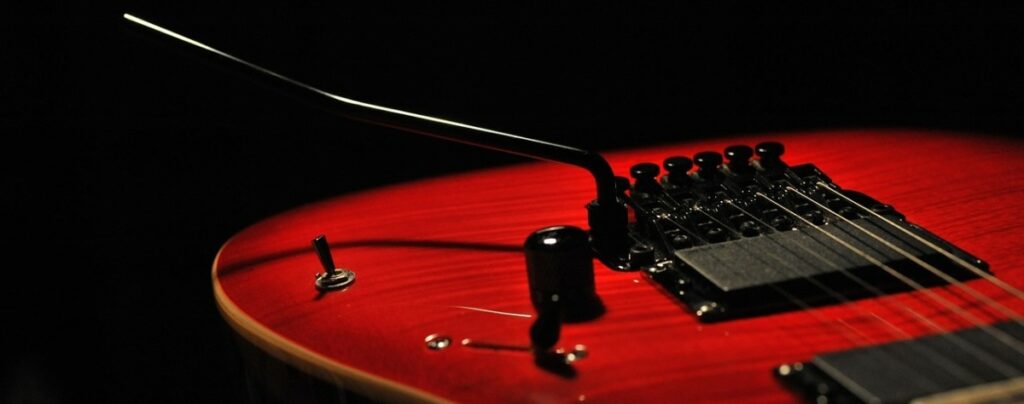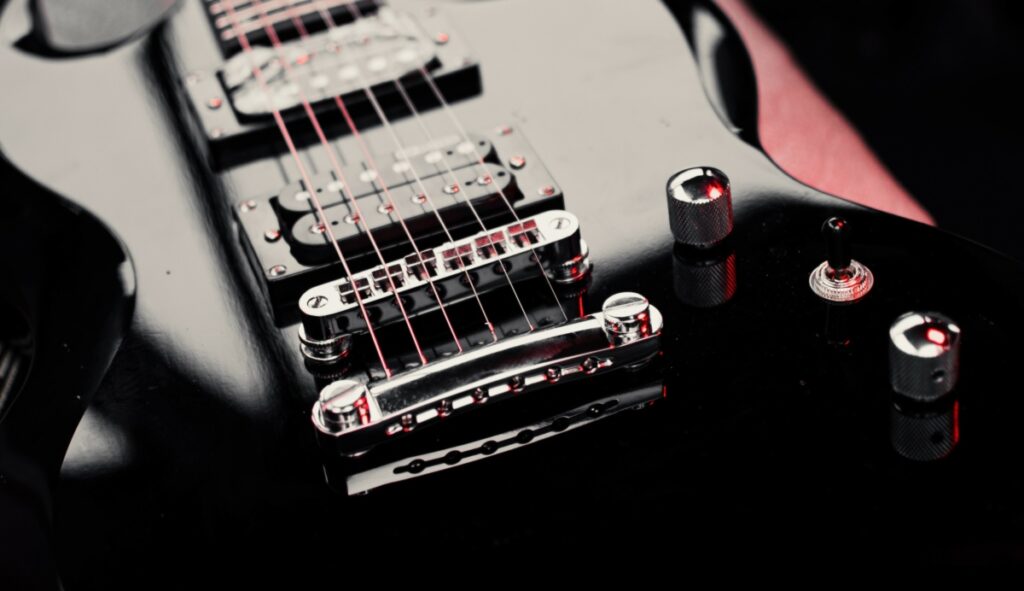ESP are one of the biggest electric guitar manufacturers in the metal scene which are well-known for producing high-end guitars. LTD is owned by ESP and produces more affordable alternatives of the flagship ESP models.
So what exactly is the difference between a guitar with ESP stamped on the headstock, and one with LTD on it instead?
ESP guitars are more expensive than LTD versions. ESP guitars are made in Japan and the USA and have better build quality compared to LTD guitars which are made in Asia. Most LTD guitars use cheaper pickups, woods and hardware and are also slightly lighter than ESP versions.
| ESP | LTD |
| Made in Japan and the USA | Made in South Korea, Indonesia and China |
| Use EMG, Seymour Duncan and Fishman Fluence Pickups | Mostly use LTD Designed Pickups however more expensive models use EMG and Fishman Fluence |
| Have a thicker maple cap | Have a thinner maple veneer |
| Made from fewer individual pieces of wood | Made from more individual pieces of wood |
| Better hardware e.g. Floyd Rose bridges, bone nut, locking tuners | Similar hardware to ESP guitars on more expensive models but inferior options on most guitars |
| Typically 1 lbs heavier | Typically 1 lbs lighter |
| Cost between $1600 and $6000 | Cost between $200 and $2000 |
Contents:
- Tone and Pickups
- Woods
- Hardware
- Manufacturing Country and Build Quality
- Feel and Playability
- Price Difference
- Which Should You Choose?
Tone and Pickups
It is possible to get ESP and LTD electric guitars which have the exact same pickups in them and hence sound almost identical (as some other specifications will still differ and affect the tone slightly). However, it is typically only the more expensive LTD guitars which use the same pickups.
On the cheaper LTD guitars, you’ll often find ESP/LTD Designed pickups which do not sound as good in my opinion as the EMG/ Fishman Fluence pickups used on the more expensive versions. ESP guitars use EMG, Fishman Fluence and Seymour Duncan pickups.
Check out this YouTube video comparing the ESP LTD and ESP Iron Cross. Both these guitars have the same James Hetfield Signature EMG pickups which are made in the USA.
Woods
- ESP guitars have a maple cap (thicker) compared to LTD guitars which have a maple veneer (thinner)
- ESP guitars are usually made from fewer pieces of wood compared to LTD guitars
- ESP guitars use a higher grade of wood compared to LTD guitars
- ESP and LTD guitars sometimes use different species of wood
For example, some of the top of the line LTD Horizon models have a maple veneer which only measures roughly 1/16″ thick, whereas the ESP Horizon guitars typically have a maple cap which is at least 1/4″ thick.
ESP guitars are usually also made with fewer piece in comparison to LTD guitars. For example, you can get 1-piece, or 3-piece bodies on an ESP guitar, but LTD models are usually made with at least 4-pieces of wood. Using fewer pieces of wood is beneficial as it helps to improve sustain and resonance. The same goes for the necks too. ESP guitars often have a 1-piece neck, whereas LTD guitars typically have 3-piece necks.
It’s also worth mentioning that ESP guitars typically use higher grades of wood compared to LTD guitars. For example, most LTD guitars use macassar ebony which is a slightly cheaper and lower grade of wood. Additionally, ESP guitars will use a higher grade of maple on guitars with flame or quilted maple tops to make them more aesthetically pleasing.
On more expensive LTD guitars, you’ll often find similar types of wood being used compared to ESP guitars, for example mahogany bodies, and rosewood/ ebony fingerboards. However on cheaper LTD guitars, you’ll often find basswood bodies and jatoba fingerboards instead which are less expensive wood species.
Hardware
When it comes to the hardware, the differences are quite minimal when comparing the most expensive LTD guitars with the least expensive ESP E-II models. It’s only when you look at the cheaper LTD models (sub $1000) that you’ll notice a significant reduction in the quality of the hardware.
- ESP guitars typically have a bone nut which offers better tuning stability compared to LTD guitars which usually have a composite (plastic) nut
- Most ESP guitars will have locking tuners whereas most LTD guitars will have standard non-locking tuners
- Less expensive LTD models will have cheaper hardware, whereas more expensive LTD models feature the same Evertune and Floyd Rose bridges seen on the ESP guitars

Manufacturing Country and Build Quality
One of the most notable differences between ESP and LTD guitars is where they are manufactured:
- ESP guitars are made in Japan and the USA
- LTD guitars are made in South Korea, Indonesia, Malaysia and China
The vast majority of ESP guitars are made in Tokyo, Japan. This includes the Custom Shop, Original series, and E-II models. In 2013, ESP also started manufacturing guitars in the Los Angeles where they exclusively make their ESP USA series of high-end electric guitars.
The more affordable ESP LTD guitars are made in Asia. The ESP LTD 1000 series is made in South Korea and the ESP 400 series is made in Indonesia. These factories do not exclusively produce ESP LTD guitars and also make guitars for other brands.
In terms of build quality, the Japanese and American-made ESP guitars are better than the ESP LTD versions. You can expect smoother fretwork, and better setup out of the box, in addition to higher quality materials when selecting an ESP guitar.
Although ESP LTD guitars are not bad quality, they are just not made with the same attention to detail and stringent quality control that goes into producing the flagship ESP guitars in Japan and the USA.
Out of all the ESP LTD guitars, it’s the Korean-made ones which have the best reputation for build quality. Compared to the cheaper Chinese and Indonesian LTD guitars, the quality is a notable improvement in my opinion and closer to the Japanese-made ESP guitars.
Feel and Playability
For the reasons mentioned above, ESP guitars typically feel a bit nicer to play (especially without a setup) compared to LTD guitars, however unless you are a very experienced player you probably won’t notice much of a difference. LTD guitars are still very nice to play out of the box.
On average, ESP guitars are heavier than LTD guitars. For example, the ESP Iron Cross weighs 8.9 lbs, and the ESP LTD Iron Cross only weighs 8.0 lbs. Some players will prefer the more solid feel of an ESP, whereas others like the lighter feel of an LTD, it’s all personal preference.
In terms of the neck profile, you’ll find that both ESP and LTD guitars will have the same dimensions and shapes, so there’s no difference here, it really is just model-specific.

Price Difference
The most obvious difference between ESP and LTD guitars is the price, with the LTD versions being significantly more affordable:
- LTD guitars cost between $200 and $2000
- ESP guitars cost upwards of $1600
As mentioned previously, there are three different series in the ESP range: ESP E-II, ESP USA, ESP Original and ESP Custom Shop. Here is how much the guitars cost in each series on average:
- ESP E-II series guitars cost between $1600 and $3400
- ESP USA cost between $3500 and $4500 on average
- ESP Original cost approximately $5000 to $6000
- ESP Custom Shop guitars cost upwards of $5000 depending on specification
As you can see, there is some crossover in price between the most expensive ESP LTD guitars and the cheapest ESP E-II) guitars.
Which Should You Choose?
This really does depend on your budget. ESP guitars are in most cases more expensive, so if you are on a tighter budget then getting an LTD is the way to go. They’re still excellent guitars, especially if you go for a South Korean version which in my opinion offers the best quality for the price.
What if you have a budget of around $1800?
In this case, you have the choice of either a top of the line ESP LTD, or one of the cheapest ESP E-II models.
This is tough, but if I was in this position I’d probably go for the ESP E-II model. The Japanese build-quality on the ESP models is excellent which in my opinion makes it the better option. You’ll also get “ESP” rather than “LTD” on the headstock which is a definite flex.
Here are some more articles you might find useful:
